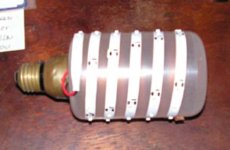OK, Amberwolf has written what I wanted to know. THANK YOU, SIR. 8) 8) Parts of this rant :lol: have been deleted. :lol:
IF I had funds, I would have bought 2-3 of those A123 Modules that were first available. A couple members had a couple that were checked out and good. Cutting out cells would have been tricky, but, NOT impossible. I missed out on that whole episode. That would have been ideal. I was tied up in a payment plan with another member, buying A123 26650 cells for my Bike build. Then I got involuntarily screw into a $1500.00, fiasco, that I had to pay, on time payments, so, Y'all can see what I am up against. SOON, all that crap will be behind me, so, I can breathe a little, and start getting battery serious.
Let me explain why I have the aversion to Lead acid. First, down here, they nearly don't exist. I go to battery stores and ask for prices on 4 Golf Car batteries. They never get back to me. I visit them 1 more time, and, ALWAYS hear, No existe'. Well i DO know they exist, in Gringoville, CR. I would buy used batteries, but, down here, EVERYTHING Goes directly for scrap ASAP. They do off gas, so, I don't want them near the house. The fumes will deteriorate the concrete plaster on the outside of the house. I have that problem now, with a lawn tractor battery I use as the computer back up, sitting 3 inches from the block portion of our house. It creates a white fungus looking stuff. Also, If I don't build cast iron case to house them, the transient thieves will steal them, or destroy them. I have thought about shipping down AGM batteries, but, they are MOSTLY built as Marine dual purpose, and, they are expensive.
My wife wants to bar all the windows and doors, to prevent breakins. I refuse to do that and live in a prison cell. I would rather shoot and bury them, thin them out, so to speak. The best price I can get is $220.00 EACH for a 6V golf car battery. Then, I have to travel over 50 miles 1 way to purchase them. I CAN NOT find any delivery service that will bring them to my house, at ANY cost ?? I can have a NiMh pack shipped down in a crate, from Florida, along with a LOT of other stuff that's not available here, for around $300.00 Delivered to my front door.
Presently, I am up to my ears trying to get my green house finished plumbing and producing. I still need to build the 3 solar panels I have parts for, but, building them and having no battery bank is kind of stoopid.
Very soon, I will have my house rewired for DC use for LED lighting. My experiments so far, are VERY encouraging. Just need a few more of the rolls of LED's from China, for $10.00 a roll, shipped. Then I will not need 100 year old tech bulbs, OR mercury gas filled lighting.
Refrigerator can be converted to a 12V or 24V DC compressor. I just need to learn refrigeration techniques, in my ultra spare time, to do a conversion. Motor home fridges use DC compressors or used to. Problem is, I can't stuff one of them into a 2' X 2' X 3' crate, but, I can get a DC compressor into one with room to spare.
Another member mentioned Edison type Ni-Fe cells. They exist, made in CHINA, so, what quality and price are we talking, again. I have read about problems with many of these Chinese cells.
I am a member of 3 other forums, DIY Electricar, Elmoto and Fieldlines. I try to keep up with new details and ideas. This one of mine seems to be shelved because y'all live in the land of plenty. Ain't SO down here, where a person can AFFORD to live, especially if he could GET stuff locally, instead of importing it.
Rant over. :lol: :lol: Anyone can respond to this thread. Doesn't matter if it helps or shoots down my plans. I also try to use bits and pieces of any advice that I can.



